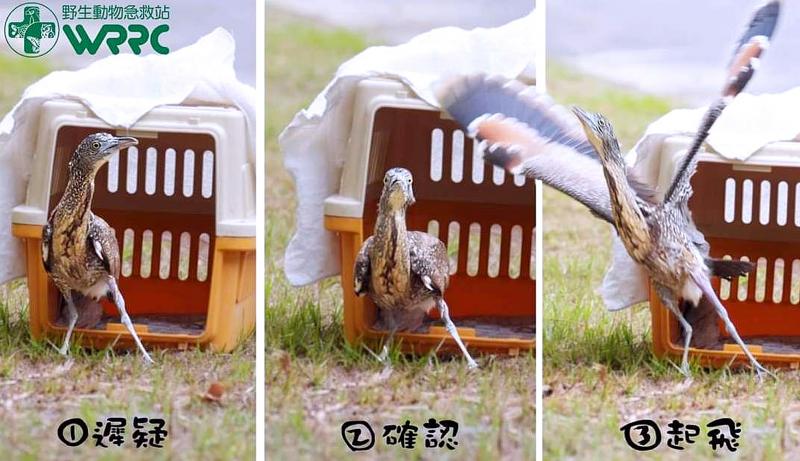Thanks to the attentive care it received at the Wildlife Rescue and Research Center (WRRC) of the Council of Agriculture’s Endemic Species Research Institute, a Malayan night heron that was lame from an injury recovered after two months of being looked after. However, as it was being released, it hesitated and held back for a while, and acted in a lovable way to show its gratitude to its caregivers and its reluctance to leave them, showing a glimpse of its intelligence.
The WRRC, which is located in Nantou County’s Jiji Township, said that when the Malayan night heron was brought in with an injury in late September, its right foot was badly broken. To prevent the stabilized fracture from becoming displaced again when the bird walked or moved around, the vets decided after some deliberation that it would be best to temporarily bandage its affected limb so that its foot would not touch the ground. However, they were worried that standing on its right leg for a long time might cause that foot to be injured too due to the pressure from its body weight. The vets then made the bird a customized pressure-relieving “foam shoe” based on the principle by which air-cushioned shoes absorb shocks and protect the wearer’s knees and ankles.
After the WRRC first posted pictures of the Malayan night heron standing on its only visible leg on its Facebook page, everyone who saw it felt distressed about its injury. Only when they found out that the bird had not had its leg amputated but only had a broken bone did they breathe a sigh of relief. They then praised the vets for their compassion and creativity.

Photo courtesy of the Wildlife Rescue and Research Center 照片:特生野生動物急救站提供
The WRRC said on its Facebook page that the vets and nursing staff all cared for the injured Malayan night heron as if it were one of their family, and when the foam footwear was removed and the bird could move around freely again, they decided to release it back into nature.
(Translated by Julian Clegg, Taipei Times)
在農委會特有生物研究保育中心野生動物急救站悉心照料下,因受傷跛腳的黑冠麻鷺,歷經兩個月來調養,終於恢復健康。不過,在野放過程中,牠也一度猶豫、遲疑並作出撒嬌狀,以示對照養人員的感謝及依依不捨之情,也讓人看到其靈性的一面﹗

Photo courtesy of the Wildlife Rescue and Research Center 照片:特生野生動物急救站提供
位於南投縣集集鎮的野生動物急救站表示,該黑冠麻鷺於九月下旬受傷被送來時,左腳已嚴重骨折。為了避免其走路或運動讓已經固定好的骨折處又位移,獸醫經一番考量後,索性將牠的患肢暫時包覆且不能著地,但又擔心長時間只靠單邊右腳站立,足部可能會承受不住身體的壓力也受傷,遂比照「氣墊鞋」對膝蓋與腳踝緩衝保護的原理,為鳥兒特別量「腳」訂作一只減壓的「泡棉鞋」。
當時急救站臉書貼出該黑冠麻鷺只剩一隻腳站立的畫面後,網友莫不心疼其傷勢,直到得知鳥兒並非被截肢,只是骨折罷了,也才鬆了一口氣,並對獸醫的貼心及創意予以高度肯定。
急救站在臉書上說,黑冠麻鷺受傷以來,獸醫、照養員等相關人員,莫不將其視為親人般照顧,且其在脫下「泡棉鞋」也能自由行動後,便決定予以野放重返大自然的懷抱。
(自由時報)

In an effort to fight phone scams, British mobile phone company O2 has introduced Daisy, an AI designed to engage phone con artists in time-wasting conversations. Daisy is portrayed as a kindly British granny, exploiting scammers’ tendency to target the elderly. Her voice, based on a real grandmother’s for authenticity, adds to her credibility in the role. “O2” has distributed several dedicated phone numbers online to direct scammers to Daisy instead of actual customers. When Daisy receives a call, she translates the scammers’ spoken words into text and then responds to them accordingly through a text-to-speech system. Remarkably, Daisy

Bilingual Story is a fictionalized account. 雙語故事部分內容純屬虛構。 Emma had reviewed 41 resumes that morning. While the ATS screened out 288 unqualified, she screened for AI slop. She could spot it a mile away. She muttered AI buzzwords like curses under her breath. “Team player.” “Results-driven.” “Stakeholder alignment.” “Leveraging core competencies.” Each resume reeked of AI modeling: a cemetery of cliches, tombstones of personality. AI wasn’t just changing hiring. It was draining the humanity from it. Then she found it: a plain PDF cover letter. No template. No design flourishes. The first line read: “I once tried to automate my

Every May 1, Hawaii comes alive with Lei Day, a festival celebrating the rich culture and spirit of the islands. Initiated in 1927 by the poet Don Blanding, Lei Day began as a tribute to the Hawaiian custom of making and wearing leis. The idea was quickly adopted and officially recognized as a holiday in 1929, and leis have since become a symbol of local pride and cultural preservation. In Hawaiian culture, leis are more than decorative garlands made from flowers, shells or feathers. For Hawaiians, giving a lei is as natural as saying “aloha.” It shows love and

1. 他走出門,左右看一下,就過了馬路。 ˇ He walked outside, looked left and right, and crossed the road. χ He walked outside and looked left and right, crossed the road. 註︰並列連接詞 and 在這句中連接三個述語。一般的結構是 x, y, and z。x and y and z 是加強語氣的結構,x and y, z 則不可以。 2. 他們知道自己的弱點以及如何趕上其他競爭者。 ˇ They saw where their weak points lay and how they could catch up with the other competitors. χ They saw where their weak points lay and how to catch up with the other competitors. 註:and 一般連接同等成分,結構相等的單詞、片語或子句。誤句中 and 的前面是子句,後面是不定詞片語,不能用 and 連接,必須把不定詞片語改為子句,and 前後的結構才相等。 3. 她坐上計程車,直接到機場。 ˇ She took a cab, which took her straight to the airport. ˇ She took a cab and it took her straight